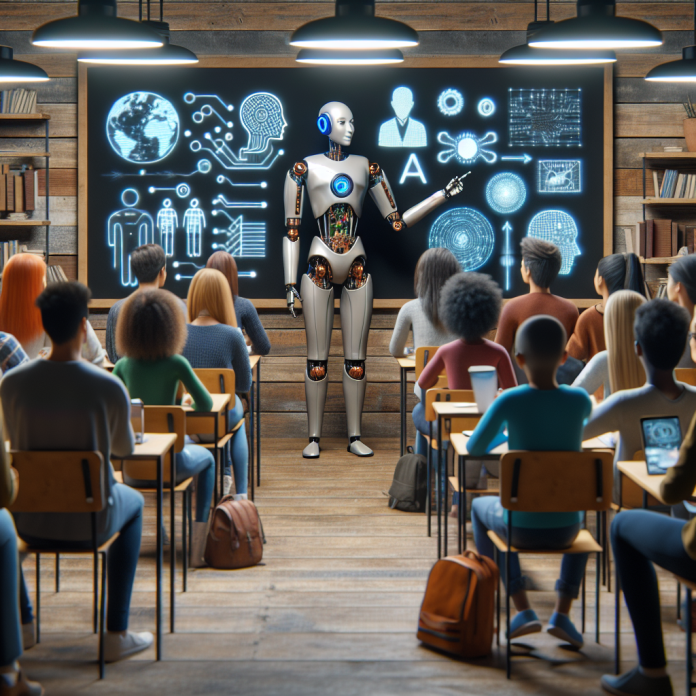**The Rise of AI in Education**
In the age of technology, Artificial Intelligence (AI) is no longer just a buzzword but a powerful tool transforming various industries – including education. The integration of AI in the field of education has the potential to revolutionize the way students learn and teachers teach. With AI, personalized learning experiences, improved student outcomes, and more efficient administrative processes are within reach. Let’s explore how AI is paving the way for a brighter future in education.
**Personalized Learning Experiences**
One of the key benefits of AI in education is the ability to tailor learning experiences to individual student needs. Traditional one-size-fits-all teaching methods are becoming a thing of the past as AI-powered platforms offer personalized recommendations based on students’ strengths, weaknesses, and learning styles. For example, adaptive learning software can analyze student performance data and adjust the difficulty level of assignments to ensure that each student is challenged at their own pace.
Furthermore, AI can provide instant feedback to students, allowing them to track their progress in real-time. This feedback loop not only helps students stay motivated but also enables teachers to identify areas where students are struggling and intervene early to provide additional support. Ultimately, personalized learning experiences made possible by AI can lead to improved student engagement and academic performance.
**Improved Student Outcomes**
With the assistance of AI, educators are better equipped to identify students who may be at risk of falling behind academically. By analyzing a myriad of data points – ranging from attendance records to assignment grades – AI can help flag warning signs early on and prompt interventions to support struggling students. For instance, an AI-powered system can alert teachers when a student’s grades suddenly drop or when they miss multiple classes in a row, enabling proactive intervention before the student falls too far behind.
Moreover, AI can help predict student performance by analyzing patterns in student data and identifying trends that may indicate future success or challenges. This predictive analytics can inform teachers’ instructional strategies, allowing them to provide targeted support to students who may need additional help. By leveraging AI in this way, educators can work towards improving student outcomes and narrowing achievement gaps.
**Efficient Administrative Processes**
In addition to enhancing student learning experiences, AI can streamline administrative processes within educational institutions. Tasks such as grading assignments, scheduling classes, and managing student records can be automated with AI, freeing up teachers’ valuable time to focus on more meaningful interactions with students. For example, AI-powered grading software can provide instant feedback on assignments, reducing the time teachers spend manually grading papers and allowing them to focus on providing personalized feedback to students.
Furthermore, AI can help optimize resource allocation within schools by analyzing data on class sizes, student-teacher ratios, and course demand. By identifying inefficiencies and recommending changes, AI can assist school administrators in making informed decisions that maximize resources and ultimately improve the overall learning environment for students.
**Real-Life Examples of AI in Education**
The impact of AI in education is already being felt in schools around the world. Take, for example, Carnegie Learning’s Mika, an AI tutor that provides personalized math instruction to students. Mika uses natural language processing to engage students in interactive conversations about math concepts, helping them build a deeper understanding of the material. By adapting to each student’s unique learning style, Mika has been shown to improve student performance and confidence in math.
Another real-life example is DreamBox Learning, an AI-powered platform that offers adaptive math instruction to students. By analyzing student data and adjusting the difficulty of assignments in real-time, DreamBox Learning helps students stay engaged and motivated as they progress through the curriculum. Teachers can track students’ progress and tailor their instruction accordingly, leading to improved learning outcomes for all students.
**Challenges and Ethical Considerations**
While the benefits of AI in education are clear, there are also challenges and ethical considerations that must be addressed. One concern is the potential for bias in AI algorithms, which may inadvertently perpetuate inequalities in education. For example, if an AI system is trained on historical data that reflects biases against certain student demographics, it may inadvertently recommend educational pathways that disadvantage those students.
Another challenge is the potential for AI to replace human teachers entirely. While AI can enhance teaching and learning experiences, it cannot replace the human connection that is essential to education. It is crucial for educators to strike a balance between leveraging AI technology and maintaining the human touch that fosters meaningful relationships between teachers and students.
**Looking Towards the Future**
As AI continues to advance, the possibilities for its application in education are limitless. From personalized learning experiences to improved student outcomes and efficient administrative processes, AI has the potential to transform the way we teach and learn. By embracing AI as a valuable tool in education, we can work towards creating a more equitable and inclusive learning environment for all students.
In conclusion, educating with AI is not just a futuristic concept but a tangible reality that is already making a positive impact in schools worldwide. By harnessing the power of AI to personalize learning experiences, improve student outcomes, and streamline administrative processes, we can pave the way for a brighter future in education. As we navigate the challenges and ethical considerations that come with integrating AI into education, it is essential to remember that the ultimate goal is to empower students to reach their full potential and succeed in an ever-changing world.

